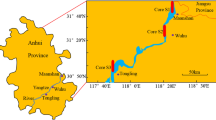Abstract
The concentrations of 16 polybrominated diphenyl ether (PBDE) congeners in six short sediment cores from the Clyde Estuary were determined by gas-chromatography mass-spectrometry. Total PBDE concentrations ranged from 1 to 2,645 μg/kg and the average concentration was 287 μg/kg. BDE-209 was the main congener and varied from 1 to 2,337 μg/kg. Elevated total PBDE concentrations were observed close to the sediment surface in the uppermost 10 cm of four of the six sediment cores. Comparison of the down core PBDE profiles revealed that the increase was driven by the accumulation of deca-BDE. Although the deca-BDE mix was dominant, the presence of lower molecular weight congeners BDE-47, BDE-99, BDE-183 and BDE-153 at most sediment intervals suggested additional sources of penta-BDE and octa-BDE pollution. Changing PBDE source input was the major factor in influencing the proportion of nona-brominated congeners, although other explanations such as post burial photo-debromination of BDE-209 cannot be entirely discounted. A clear cascading to lower hepta-, hexa-, and penta-homologues was not found. The increase in total PBDE concentrations and particularly the deca-BDE may possibly be ascribed to the use and subsequent disposal of electrical appliances such as televisions and computers. In the Clyde sediments, the proportion of nona-brominated congeners was higher than that reported for commercial mixtures. This might be due to changing sources of PBDEs or post burial photo-debromination of BDE-209.





Similar content being viewed by others
References
Alaee, M., Arias, P., Sjödin, A., & Bergman, Å. (2003). An overview of commercially used brominated flame retardants, their applications, their use patterns in different countries/regions and possible modes of release. Environment International, 29, 683–689. doi:10.1016/S0160-4120(03)00121-1.
Alcock, R., Johnston, A. E., McGrath, S. P., Berrow, M. L., & Jones, K. C. (1993). Long-term changes in the polychlorinated biphenyl content of United Kingdom soils. Environmental Science and Technology, 27, 1918–1923. doi:10.1021/es00046a022.
Allchin, C. R., Law, R. J., & Morris, S. (1999). Polybrominated diphenylethers in sediments and biota downstream of potential sources in the UK. Environmental Pollution, 105, 197–207. doi:10.1016/S0269-7491(98)00219-X.
Hale, R. C., La Guardia, M. J., Harvey, E. P., Gaylor, M. O., Mainor, T. M., & Duff, W. H. (2001). Flame retardants—persistent pollutants in land-applied sludges. Nature, 412, 140–141. doi:10.1038/35084130.
Harrad, S., Ibarra, C., Diamond, M., Melymuk, L., Robson, M., Douwes, J., et al. (2008). Polybrominated diphenyl ethers in domestic indoor dust from Canada, New Zealand, United Kingdom and United States. Environment International, 34, 232–238. doi:10.1016/j.envint.2007.08.008.
Hassanin, A., Breivik, K., Meijer, S. N., Steinnes, E., Thomas, G. O., & Jones, K. C. (2004). PBDEs in European background soils: Levels and factors controlling their distribution. Environmental Science and Technology, 38, 738–745. doi:10.1021/es035008y.
Hoh, E., & Hites, R. A. (2005). Brominated flame retardants in the atmosphere of East-Central United States. Environmental Science and Technology, 39, 7794–7802. doi:10.1021/es050718k.
Klamer, H. J. C., Leonards, P. E. G., Lamoree, M. H., Villerius, L. A., Akerman, J. E., & Bakker, J. F. (2005). A chemical and toxicological profile of Dutch North Sea surface sediments. Chemosphere, 58, 1579–1587. doi:10.1016/j.chemosphere.2004.11.027.
Law, R. J., Allchin, C. R., de Boer, J., Covaci, A., Herzke, D., Lepom, P., et al. (2006). Levels and trends of brominated flame retardants in the European environment. Chemosphere, 64, 187–208. doi:10.1016/j.chemosphere.2005.12.007.
Mai, B. X., Chen, S. J., Luo, X. J., Chen, L. G., Yang, Q. S., Sheng, G. Y., et al. (2005). Distribution of polybrominated diphenyl ethers in sediments of the Pearl River Delta and adjacent South China Sea. Environmental Science and Technology, 39, 3521–3527. doi:10.1021/es048083x.
Rahman, F., Langford, K. H., Scrimshaw, M. D., & Lester, J. N. (2001). Polybrominated diphenyl ether (PBDE) flame retardants. The Science of the Total Environment, 275, 1–17. doi:10.1016/S0048-9697(01)00852-X.
Rost, H., Loibner, A. P., Hasinger, M., Braum, R., & Szolar, O. H. J. (2002). Behaviour of PAHs during cold storage of historically contaminated soil samples. Chemosphere, 49, 1239–1246. doi:10.1016/S0045-6535(02)00497-6.
Soderstrom, G., Sellstrom, U., De Wit, C. A., & Tysklind, M. (2004). Photolytic debromination of decabromodiphenyl ether (BDE 209). Environmental Science and Technology, 38, 127–132. doi:10.1021/es034682c.
Talsness, C. E. (2008). Overview of toxicological aspects of polybrominated diphenyl ethers: A flame-retardant additive in several consumer products. Environmental Research, 108, 158–167. doi:10.1016/j.envres.2008.08.008.
Vane, C. H., Harrison, I., & Kim, A. W. (2007a). Assessment of polyaromatic hydrocarbons (PAHs) and polychlorinated biphenyls (PCBs) in surface sediments of the inner Clyde estuary, UK. Marine Pollution Bulletin, 54, 1301–1306. doi:10.1016/j.marpolbul.2007.04.005.
Vane, C. H., Harrison, I., & Kim, A. W. (2007b). Polycyclic aromatic hydrocarbons (PAHs) and polychlorinated biphenyls (PCBs) in sediments from the Mersey estuary, UK. The Science of the Total Environment, 374, 112–126. doi:10.1016/j.scitotenv.2006.12.036.
Wang, Y., Jiang, G., Lam, P. K. S., & Li, A. (2007). Polybrominated diphenyl ether in the East Asian environment: A critical review. Environment International, 33, 963–973. doi:10.1016/j.envint.2007.03.016.
Webster, L., Russell, M., Adefehinti, F., Dalgarno, E. J., & Moffat, C. F. (2008). Preliminary assessment of polybrominated diphenyl ethers (PBDEs) in the Scottish aquatic environment, including the firth of Clyde. Journal of Environmental Monitoring, 10, 463–473. doi:10.1039/b718687h.
Zegers, B. N., Lewis, W. E., Booij, K., Smittenberg, R. H., Boer, W., De Boer, J., et al. (2003). Levels of polybrominated diphenyl ether flame retardants in sediment cores from Western Europe. Environmental Science and Technology, 37, 3803–3807. doi:10.1021/es034226o.
Acknowledgments
Sincere appreciation is expressed to the staff at the Scottish Environment Protection Agency (SEPA) and particularly captain Hugh Anderson and technicians John Derrick and James Glendinning of the SEPA vessel ‘Endrick II’. We also thank BGS staff J. Ridgway, T. R. Lister and M. H. Strutt for core collection. Nigel Birch at the British Consulate-General, Guangzhou provided logistic support to C. H. Vane during two visits to Guangzhou in 2006–2007. This paper was published by permission of the Executive Director, British Geological Survey.
Author information
Authors and Affiliations
Corresponding author
Rights and permissions
About this article
Cite this article
Vane, C.H., Ma, YJ., Chen, SJ. et al. Increasing polybrominated diphenyl ether (PBDE) contamination in sediment cores from the inner Clyde Estuary, UK. Environ Geochem Health 32, 13–21 (2010). https://doi.org/10.1007/s10653-009-9261-6
Received:
Accepted:
Published:
Issue Date:
DOI: https://doi.org/10.1007/s10653-009-9261-6




